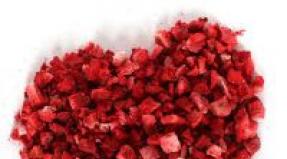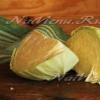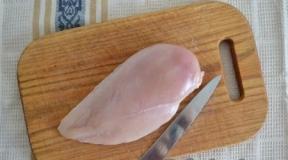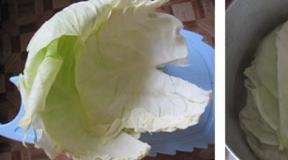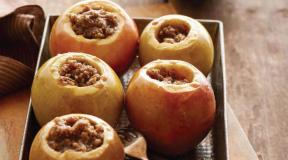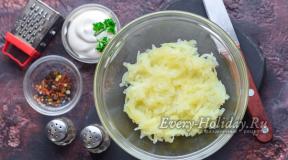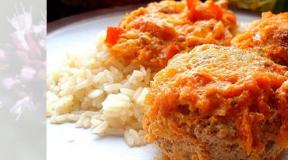Sesame tahini paste - a recipe with a photo, how to cook at home. What is tahini - the benefits and harms of sesame paste, recipes for cooking at home with a photo
In the old days, tahini was considered the food of the rich. In some countries, sesame paste was used as a currency to exchange goods. Later it became everyday food. Now the product is served as an independent dish, included in the composition of sauces, for example, the legendary Middle Eastern seasoning hummus.
In Turkey, pasta is mixed with fruit syrup. In Iraq, it is spread on bread along with, in Greece - with honey. The Iranians make halva from tahina, the Cypriots make souvlaki seasoning for kebabs, and the Egyptians add an oily snack to fried meat. In the East, they say that sesame paste is an ideal food, because it gives energy and strength, is well digested, and maintains healthy skin.
Half a century ago, tahini appeared in health food stores in the United States and Europe. Western scientists have investigated the biochemical properties of the product. In the composition, such an amount of protein, vitamins, calcium and polyunsaturated fats was found that tahini can be called a "superfood" - a particularly healthy food. Sesame paste is recommended for use in diseases of the bones, joints, skin, as well as for the prevention of many diseases.
The composition and calorie content of pasta
The basis of tahina is sesame (sesame). The grains of this oilseed are fried, ground and seasoned with vegetable oil. The resulting product retains the valuable substances of sesame and even accelerates their action, as it is better absorbed in the form of an oily cream. 100 g of pasta contains 18 g of protein, 51 g of fat and 18.5 g of carbohydrates. Despite the sweetish taste and high fat content, tahini does not contain sugar, and 88% of fatty acids are polyunsaturated.
|
Substance |
Content in 100g of product |
| Vitamin A |
3 mcg |
| Vitamin B1 |
0.24 mg |
| Vitamin B2 |
0.2 mg |
| Vitamin B5 |
0.052 mg |
| Vitamin B6 |
0.816 mg |
| Vitamin B9 |
100 mcg |
| Vitamin PP |
6.7 mg |
| Calcium |
960 mg |
| Magnesium |
362 mg |
| Sodium |
12 mg |
| Potassium |
582 mg |
| Phosphorus |
659 mg |
| Iron |
19.2 mg |
| Zinc |
7.29 mg |
| Copper |
4214 mg |
| Manganese |
2.54 mg |
| Selenium |
5.9 mcg |
With all the usefulness of tahini, it is impossible to get carried away with this product because of its high calorie content - 586 Kcal.
Health benefits of sesame paste

In the old days, when the biochemical composition of tahini was unknown, people valued the product for its high fat content and nutritional value. And for good reason - contained in Omega-3 fatty acids effectively fight bad cholesterol. Healthy fats cleanse the walls of blood vessels and increase their elasticity. Scientific studies have proven that if you use 2 tbsp. spoons of tahini daily for 1.5 months, you can significantly improve the condition of blood vessels and the heart.
Sesame paste has a beneficial effect on people with serious diseases such as:
- type 2 diabetes;
- hypertonic disease;
- knee arthritis;
- atherosclerosis;
- neurasthenia;
- depression.
Tahini contains 4 substances that are extremely important for immunity: iron, zinc, selenium and copper. They produce white blood cells that destroy germs. Regular use of sesame paste protects against seasonal SARS and influenza, accelerates recovery from infectious diseases.
Unlike whole sesame seeds, tahini is easier to digest. What's more, fatty acids stimulate the liver and gallbladder to help process other foods faster. As an excellent source of fiber, tahini is recommended for people suffering from sluggish digestion and constipation.
Tahini for Women's Health
Sesame paste is especially important for menopausal women as a source of phytoestrogens. These substances help to correct the level of estrogen and progesterone and mitigate the effects of hormonal imbalance. Adding 2-3 tablespoons of tahini to food daily, you can significantly reduce the manifestations of menopause - hot flashes, weakness, mood swings. The high calcium content in the product prevents bone loss and osteoporosis.
There is scientific evidence that phytoestrogens protect against cancers associated with the production of hormones - breast and ovarian cancer.
In addition, sesame paste helps women of any age in caring for their appearance. The product can not only be eaten, but also applied to the skin and hair as masks. Vitamins and fatty acids add shine to the hair, tighten and strengthen the skin.
Sesame paste for men's health
Tahini is an excellent natural remedy for improving libido and erectile function. The product is rich in one of the main trace elements for the production of male hormones - zinc. There is as much zinc in sesame paste as in the famous aphrodisiac, oysters, with the difference that delicacy clams are much more expensive.
Often the cause of men's fiasco in bed is chronic fatigue and depression. Polyunsaturated fatty acids, which are so abundant in tahini, stimulate the production of serotonin. This "hormone of happiness" relieves tension, increases sexual desire.
Another common cause of erectile dysfunction is high blood pressure. Omega-3 fatty acids effectively contribute to its reduction. Vitamin E, which doctors have long called the "vitamin of sex", contributes to the production of testosterone, the main male hormone. In addition, vitamins E and B2 improve the condition of the skin, increasing the external attractiveness of a man.
To get rid of most sexual problems, it is enough for the stronger sex to eat 3-4 tablespoons of tahini per day.
How to make tahini pasta: homemade recipe

The main condition for preparing an oriental snack is to use high-quality sesame seeds. The procedure is as follows:
- Soak the seeds in cold water for 1-2 hours, then drain the water through a fine sieve and dry.
- Roast the seeds for 10 minutes. in a skillet without oil over low heat.
- Grind in a food processor or blender.
- Add a little vegetable oil to the blender so that the mass is not too thick. Oil can be taken sesame, olive or.
- Pour into a glass dish and refrigerate or eat immediately.
It is easy to make homemade hummus from tahini. To do this, 100 g of paste is combined with 1 crushed garlic clove, 50 g of lemon juice, 2 tbsp. spoons of olive oil and 400 g boiled. All products are ground in a blender and seasoned to taste with salt and pepper. The sauce goes well with meat and fish dishes, stewed vegetables, bread and hard-boiled eggs.
Side effects and contraindications
Despite its health value, sesame paste can harm people suffering from certain diseases. Among them:
- Obesity. Saturated with fats and proteins, tahina is a high-calorie product. Overweight people should not consume more than 1 tbsp. spoons of the product per day
- . Like many cereals and nuts, sesame often causes allergic reactions - skin rash, swelling of the eyes, runny nose, shortness of breath.
- Diseases of the liver, pancreas and gallbladder. In chronic diseases of these organs, excess fat leads to diarrhea, vomiting and acute pain.
Even a healthy person, with the abuse of fatty and high-calorie pasta, can feel nausea and indigestion. There is no exact norm for using the product, but doctors recommend not to exceed 5 tablespoons per day. To make tahini better absorbed, it is recommended to mix it with lemon juice and chopped garlic.
How to choose and store
Pasta varieties produced in the Middle East - in Lebanon, Palestine and Israel - are considered the best in taste. Greek, Turkish and Cypriot products have a less intense taste and aroma. The healthiest foods are found in health food stores. They are made from sesame seeds grown without the use of chemical fertilizers, do not contain flavorings and preservatives.
After opening a jar of tahini, the contents must be vigorously mixed so that the oil that has come out on the surface is combined with the paste. After each use, the jar is placed in the refrigerator. Sesame paste is stored from 6 months. up to 2 years. However, vegetable oils can go rancid over time. Organic health food store pasta and homemade tahina have the shortest shelf life, as they contain no preservatives. Such products are best consumed within 1 month after purchase or preparation.
If the paste is stored long enough, it should be smelled or tasted before use. Rancid oil has a very characteristic odor and bitter taste. A spoiled product cannot be used as food even when cooked - it can cause poisoning.
Many have heard of the delicious tahini pasta. Many people know what it is, but not everyone knows that this sesame paste, also called tahina and tahina, can be prepared independently without much effort. This ingredient is considered an indispensable component for all oriental dishes. Today we offer a recipe for tahini. Let's get to know him step by step.
Tahini - what is it?
Yet there are people who are not aware of what this fragrant paste is. The main ingredient of the sauce is sesame seeds, which can be purchased at almost any store. Tahini is especially appreciated by lovers of original oriental cuisine and vegetarians. The latter fell in love with pasta for its calorie content, it is very satisfying, which is why, if you monitor the condition of your figure, you should not be zealous with eating it, as it will quickly be deposited in problem areas of the body.
Tahini - what is it? This is a very valuable and useful product. The paste contains a lot of fatty acids, vitamin B and minerals. By eating tahini, you improve the condition of your hair, prevent acne, and your skin becomes healthier and fresher. In addition, the product has a beneficial effect on digestion, and therefore on the body as a whole.
If you add yogurt or plain drinking water to tahini, you get a fragrant sauce that ennobles vegetable dishes, salads and unleavened cakes. Feel free to use tahini during fasting. What it is - now you know, it is a healthy, tasty and satisfying addition to any meal.

Choosing the right sesame
The preparation of tahini is a simple process, the result of the taste will depend on the selected ingredients. You will need 300 grams of sesame seeds and four tablespoons of extra virgin olive oil. If problems cannot arise with the second component, then the first one must be able to select.
Arriving at a store or shop that sells such products, ask the seller to give out two or three sesame seeds for testing. Chew them well, distribute them throughout the mouth. There should be no signs of bitterness in the taste, even a small amount of it will completely ruin the pasta.
Seed preparation
Cooking pasta is very simple, but for this you need to properly prepare the seeds. Many women prefer to fry sesame immediately after buying it, after which the sauce turns out to be heterogeneous, small pieces come across, and tahini should be completely puree. So, first of all, the seeds must be soaked for four hours in water at room temperature. Put the ingredient in a deep container, fill it so that there is a centimeter more water. After the time has elapsed, drain the water and keep the product in the refrigerator for another four hours.

Roasting
Place the sesame seeds in an even layer on a baking sheet lined with baking paper if there is no non-stick coating. To begin with, heat the oven to 180 degrees, after the seeds have dried, increase the temperature to 200. The roasting time is about 20 minutes along with drying, during which you need to remove the baking sheet from the oven several times, mix the seeds. Readiness is easy to check, they should become a beautiful golden color, do not overcook, in which the sesame will turn dark brown.
Of course, you can do otherwise by frying the seeds in a pan. During drying, do not cover the dishes with a lid.

cooking tahini
When the seeds are well fried, pour them into another container until they cool completely. After that, place the ingredient in a blender bowl and grind them for several minutes at low, and then at high speed. First of all, sesame will break into small particles, from which oil will appear, and it will contribute to the complete abrasion of the seeds in the puree. If the process drags on and the particles do not rub off for a long time, add half (2 tablespoons) of cooked olive oil. After that, the paste will form faster. At the end of the process, add the remaining oil, mix the components with a blender for another four minutes. That's it, the sesame tahini is ready.

Additional components
As mentioned earlier, tahini sauce is prepared depending on the recipe of the dish for which this ingredient will be needed. Add water, salt, yogurt or lemon juice to the paste. If you prepare the sauce immediately after cooking the pasta, you can add a tablespoon of sesame oil to it, but not refined, so the component will acquire an even brighter flavor. If tahini is prepared for the future and will be stored in the refrigerator, it is better not to add anything extra so that the paste is stored for a longer time and does not lose its taste and smell.

What to cook with tahini?
In this sauce, you can dip pieces of grilled meat, fresh vegetables, pita bread. Without tahini, you will not get a full-fledged hummus, this sauce will complement its taste. We bring to your attention this particular recipe, it really deserves attention.
You will need to take two cups of chickpeas, also called chickpeas and garbanzo. Drain off all available liquid. Other Ingredients:
- the third part of a glass of tahini - what it is and how to cook it, we have already told;
- four tablespoons of lemon juice;
- a teaspoon of salt;
- two cloves of garlic, cut in half;
- a pinch of paprika and a teaspoon of any greens;
- a tablespoon of refined olive oil.
Turn all the ingredients, except for herbs and butter, in a blender, put on a flat dish in an even layer. After that, make longitudinal grooves, pour with oil and decorate with herbs.
Those who were in the East may have seen jars on sale with the name “Tahini”, unknown to many. What is hidden behind these six letters? Turns out, tahini is a thick paste made from ground sesame seeds. The first mention of tahini, which is often also called sesame paste, is found in cuneiform instructions written about four thousand years ago. These sources tell of the custom of serving sesame wine to the gods. If you are not planning to go on a trip in the near future, but want to try this unusual dish, then we suggest cooking it at home. Fortunately, this is not as difficult as it might seem.
Tahini is eaten in Greece and Cyprus, where pies with this pasta are especially popular during Lent. A well-known appetizer in Israeli cuisine (by the way, in Israel it is called tkhina). In China, Japan, and Korea, tahini is considered an important ingredient in a wide range of dishes. Pasta goes well with vegetables and fish, before use it must be diluted with water to the consistency of sour cream, lemon juice, garlic and salt are also added to it. Often, pasta becomes an ingredient for many oriental sweets, including halva. It is also used to make the world-famous snack - hummus. Some even eat tahini spread on bread or flatbread.
tahini benefits
Tahini is not only tasty, but also healthy. Pasta is considered a source of a large amount of vegetable proteins that give strength and youth to the body. The paste contains essential fatty acids omega-3 and omega-6, which are not produced by our body. Tahini also contains a small amount of calcium, iron, copper and phosphorus. Among the valuable elements present in the paste, methionine is noted, which cleanses the liver of poisons, as well as alkaline minerals that promote weight loss. The results of the study of the product say that tahini helps in the fight against diabetes, as well as Alzheimer's disease, and regularly feasting on sesame paste, you reduce the risk of cancer and cardiovascular diseases.
Tahini. Classic recipe
You will need:
- sesame - 100 grams,
- sesame oil - 1-2 tablespoons.
Cooking method
- Put the sesame seeds on a baking sheet. Before cooking, be sure to taste the seeds, in no case should they be bitter. We send it to the oven for 8-10 minutes to brown a little (do not overdo it, otherwise the taste of the finished product will be far from the original), do not forget to shake occasionally.
- Pour the toasted sesame seeds into a blender and, gradually pouring in sesame oil (by the way, it can be replaced with walnut, olive or any other not very smelling), beat until a smooth, uniform, creamy consistency.
- If during cooking you followed all the recommendations, then you should get a mass that is similar in consistency to thick viscous sour cream.
- Ready tahini is recommended to be stored in a tightly closed container in the refrigerator for no more than 2 months.
We said that some people eat pasta just by spreading it on bread, but if it seems very concentrated to you, you can vary its taste by adding ingredients to it according to your own desire. As we mentioned above, some add garlic to it, others put finely chopped greens, and still others mix sesame paste with honey and eat it after as a dessert. The original taste is obtained if you add a little to the paste lemon juice. Experiment, try and you will definitely find the combination of tahini that seems perfect to you. Bon Appetit!
Tahini - health and beauty benefits. Tahini, tahina or tahini(also known as sesame paste) - a thick, fatty paste made from ground sesame seeds common in the Middle East, it is added to many dishes, such as falafel, hummus, it serves as the basis for many sauces. The composition of tahina includes ground sesame seeds (100%).
Tahini, tahina or tahini(also known as sesame paste) - a thick, fatty paste made from ground sesame seeds common in the Middle East, it is added to many dishes, such as falafel, hummus, it serves as the basis for many sauces. The composition of tahina includes ground sesame seeds (100%).
When used, the paste is diluted with water to the consistency of liquid sour cream, lemon juice, salt and garlic are added. The classic appetizer hummus should be prepared on the basis of tahini (tahina) paste. Tahini is well known in the cuisine of Israel (where it is called "tkhina"), Greece, Cyprus - Cypriot pies with tahini "tahina pita" are very popular.
Tahini mass is used to prepare many oriental sweets, including one of the most famous - halva.
Tahini is similar in texture to peanut butter.
1 tablespoon contains 85 calories, 7.2 g fat, 3.2 g carbohydrates, 2.6 g protein. It is an excellent source of beneficial fatty acids, with 60.1 mg of omega-3 and 3.4 mg of omega-6 per serving.
Our body cannot produce these vital substances, so they must be included in the diet to promote heart and brain health.
The paste also contains calcium, iron, copper and phosphorus - minerals that provide strength to bones and teeth, cleanse the kidneys (especially if you take antacids and diuretics), strengthen blood vessels, promote the production of red blood cells, give energy, prevent anemia.
Another important component of tahini is thiamine or vitamin B1. Each serving provides 16% of the Daily Value of this nutrient. It has a beneficial effect on the nervous system, muscles and digestion.
Thiamine deficiency can cause complications of heart and gastrointestinal diseases.
Health Benefits of Tahini
Sesame paste is a key product in the cuisine of the Middle East. It is she who gives a special taste and texture to classic oriental dishes. But the special charm lies in the large number of useful properties, many of which are aimed at improving the appearance.
For clear, glowing skin, healthy hair, and a flawless figure, eat tahini with meat and seafood!
It is an excellent source of methionine, which cleanses the liver of poisons, as well as alkaline minerals that promote weight loss.
We establish digestion
For people suffering from indigestion, this is truly a fabulous product!
In the production of the paste, sesame seeds are ground so hard that a homogeneous paste is obtained, which the body easily accepts and digests.
Sesame paste can be used without fear even by those who suffer from gastrointestinal disorders.
It will not only saturate the body with nutrients, but also help digest heavier foods.
We treat acne
According to the University Health Center in Illinois, 80-90% of today's teenagers suffer from acne and skin sores.
Acne appears for a variety of reasons, from bacterial contamination and commonplace uncleanliness, to overproduction of pore-blocking fat and a diet high in carbohydrates.
There are many home remedies for acne (such as benzoyl peroxide and salicylic acid), but you may not be familiar with tahini-based recipes.
Sesame paste is rich in zinc, the effectiveness of which in the treatment of acne has been confirmed by the employees of the Medical Center in Maryland.
We prevent hair loss.
Hair loss is often a sign of metabolic disorders.
A balanced diet normalizes metabolism and replenishes the nutritional deficiencies (especially zinc) that hair needs so much.
Other symptoms of zinc deficiency include taste disturbances, diarrhea, impotence, vision problems, acne, and lack of appetite.
A 100-gram serving of tahini contains 10 mg of zinc, which is 70% of the daily value.
Other zinc-rich foods include oysters, wheat germ, calf's liver, dried watermelon seeds, dark chocolate, cocoa powder, lamb, and peanuts.
Sesame paste inherited all the beneficial properties of sesame seeds. But its undeniable advantage is its delicate, pleasant to the taste and easy-to-digest texture.
I present the recipe for sesame paste and its application
Calories per meal: 1300Estimated cost: 149.25 rub. Moscow
Ingredients:
1 st. sesame (130 gr.) Sesame should be fresh and in no case bitter!
5-6 tbsp (50 ml) vegetable oil (unscented)
How to cook
Place the sesame seeds on a baking sheet lined with baking paper and toast it in the oven for a bit, shaking the baking sheet from time to time so that the sesame seeds do not burn. (I did this in the microwave.)
When the sesame becomes slightly golden and begins to smell fragrant, pull out and punch in the processor (blender), gradually adding vegetable oil - ideally sesame. You can also nutty or any other with a neutral taste.
Beat until smooth, until the sesame is creamy, the consistency of medium thickness of honey.
Everything, tahini is ready.
It can be used to make hummus, meat and vegetable sauces, and baked goods. Store in the refrigerator in a jar with a tight lid for up to 2 months.
A very useful recipe for those who do not have the opportunity to buy sesame paste.
But this is the basis. And if you use tahini as a sauce for fish, meat and vegetables, then lemon juice, crushed garlic, salt, ground pepper are also added to it.
True, we have tahini already ready, concentrated. It is only necessary to dilute with water and add all the additives.
Kufta in Jordanian tahini sauce - recipe.

Calories per meal: 2115
Estimated cost: 254.65 rub. Moscow
Recipe step by step photos



Ingredients:
. 400 grams lamb meat + beef
. 1 large onion
. bunch of green parsley
. 2-3 garlic cloves
. black-red pepper, nutmeg, zira, salt to taste
. 200 gr tahini paste
. 2 lemons (juice of them)
. 1 tsp dry garlic
. 200 gr water
. 1 tsp salt
. 1 tbsp melted butter for greasing, 1 tbsp olive oil, a handful of pine nuts.
How to cook
Ground meat:
Twist the meat in a meat grinder 2 times.
Just twist in a meat grinder 1 large onion + parsley + garlic 2-3 cloves.
Add spices (I put black and red pepper, cumin, nutmeg + salt to taste) and mix the minced meat.
Tahini Sauce:
. 200 grams of tahini
. juice from 2 lemons
. 200 grams of water
. 1 tsp dry garlic.
Beat everything in a mixer.
Now we take a non-stick baking sheet (form), grease it with melted butter, lay out our minced meat and pour it lightly
olive oil.
We put it in the oven to get golden, the temperature should be 180-200 degrees. As the kufta becomes golden (do not drain the broth formed from the meat), then pour our tahini sauce on top of the kufta, make the temperature 150 g and bring to readiness.
The sauce needs to thicken. Separately fry the pine nuts and sprinkle them over the finished dish. Also sprinkle with cilantro. Pickles and fried potatoes go very well with this dish.
27.04.2015
Tkhina, tahini, tahina, sesame paste or sesame paste- all this is the same ingredient, which is part of many Israeli and Middle Eastern dishes, such as, and . When I traveled around Israel, tahini was added everywhere and in all dishes, it was sold in every small and large store, from the grocery store under the house to hypermarkets. Returning to my country, of course, I didn’t find it on the shelves, so I set out to cook tahini on my own. It turned out that it is not so difficult. Let's try! .
Ingredients
- - 400 gr (unroasted, non-bitter)
- - or olive odorless - 2-3 tbsp
Cooking method
Prepares very quickly. To make delicious tahini sesame paste, you need to choose the right sesame seeds. Try it before you buy it, it shouldn't be bitter otherwise the sesame paste will be bitter too. We measure the right amount of sesame seeds.  Pour half into the blender chopper and start grinding. When the sesame turns into gruel, add the second half and grind again.
Pour half into the blender chopper and start grinding. When the sesame turns into gruel, add the second half and grind again.  This may take about 5 minutes. If you use a coffee grinder, the result, of course, will be much better and you will achieve the desired consistency faster. My blender can only grind as shown in the photo below, but the finer the better.
This may take about 5 minutes. If you use a coffee grinder, the result, of course, will be much better and you will achieve the desired consistency faster. My blender can only grind as shown in the photo below, but the finer the better.  Add sesame oil. And we grind again.
Add sesame oil. And we grind again.  Due to the fact that sesame seeds are very hot, the consistency should be homogeneous and liquid. Then the tahini will thicken a little in the refrigerator. If the consistency is uneven, add a little more oil and grind again until we achieve the desired result.
Due to the fact that sesame seeds are very hot, the consistency should be homogeneous and liquid. Then the tahini will thicken a little in the refrigerator. If the consistency is uneven, add a little more oil and grind again until we achieve the desired result.  ready for further use. Many people already use this tahina as a separate sauce, but there is a classic (with the same name)
ready for further use. Many people already use this tahina as a separate sauce, but there is a classic (with the same name)


